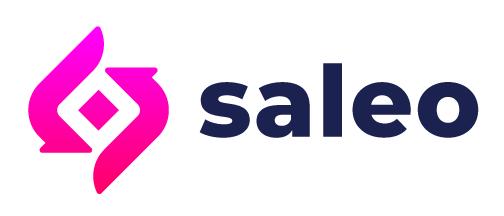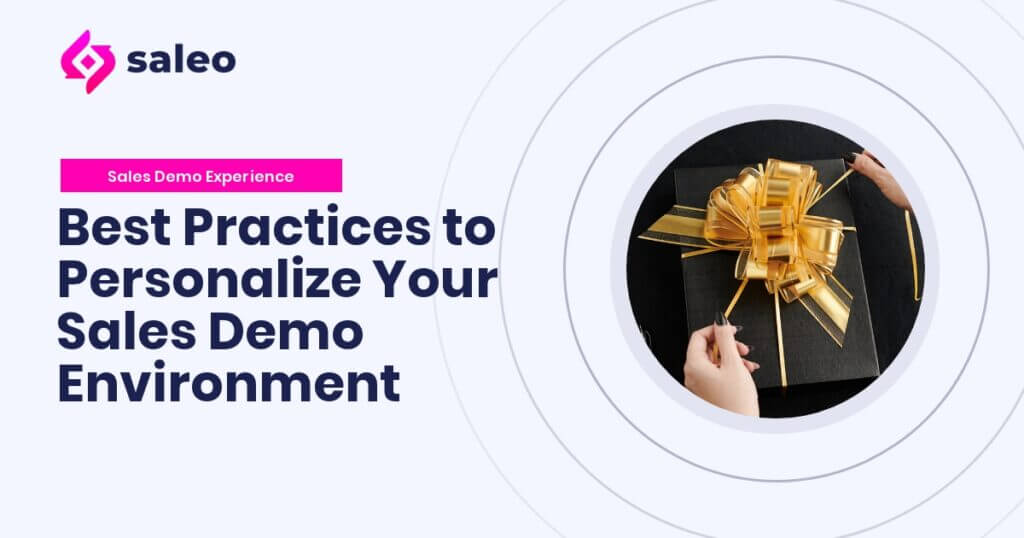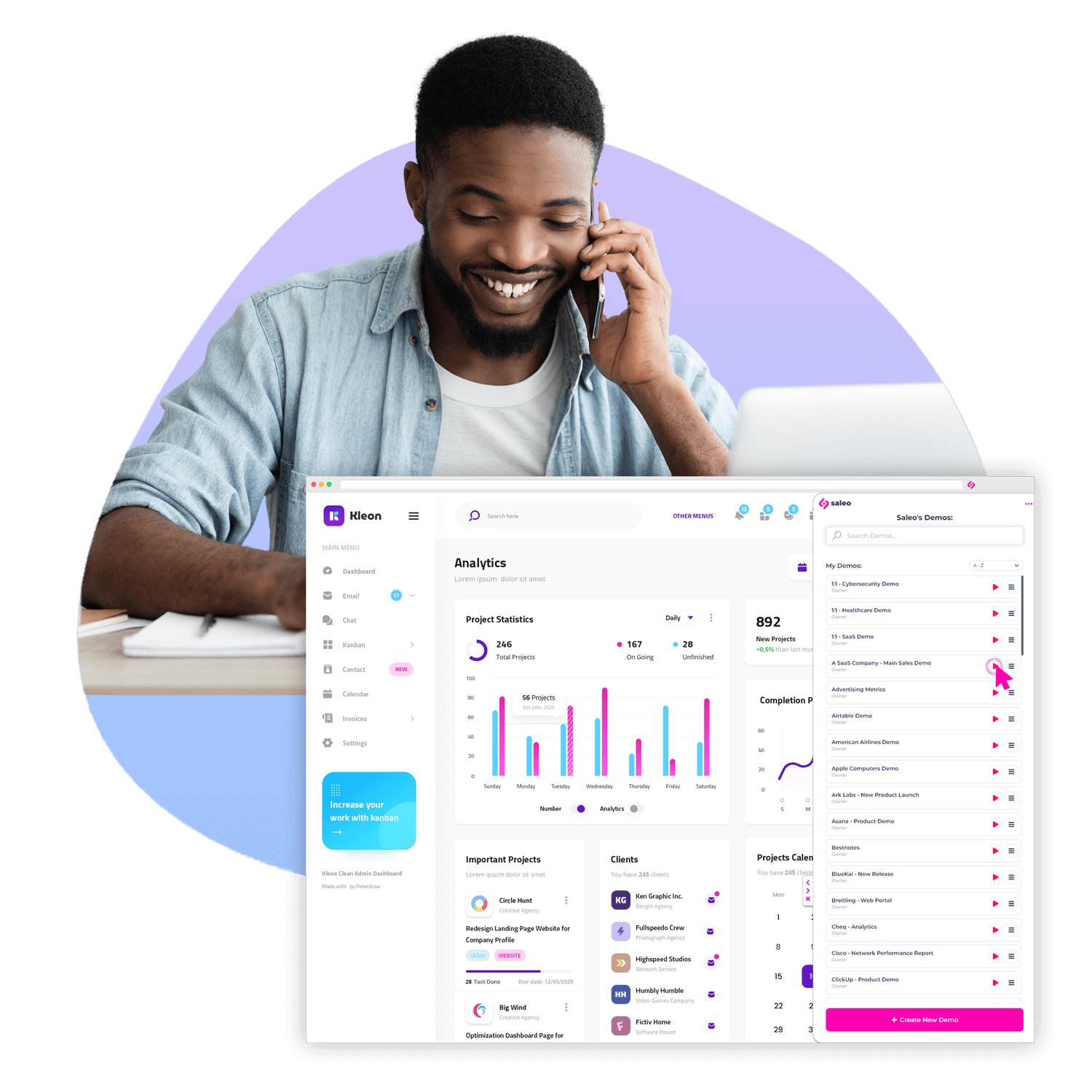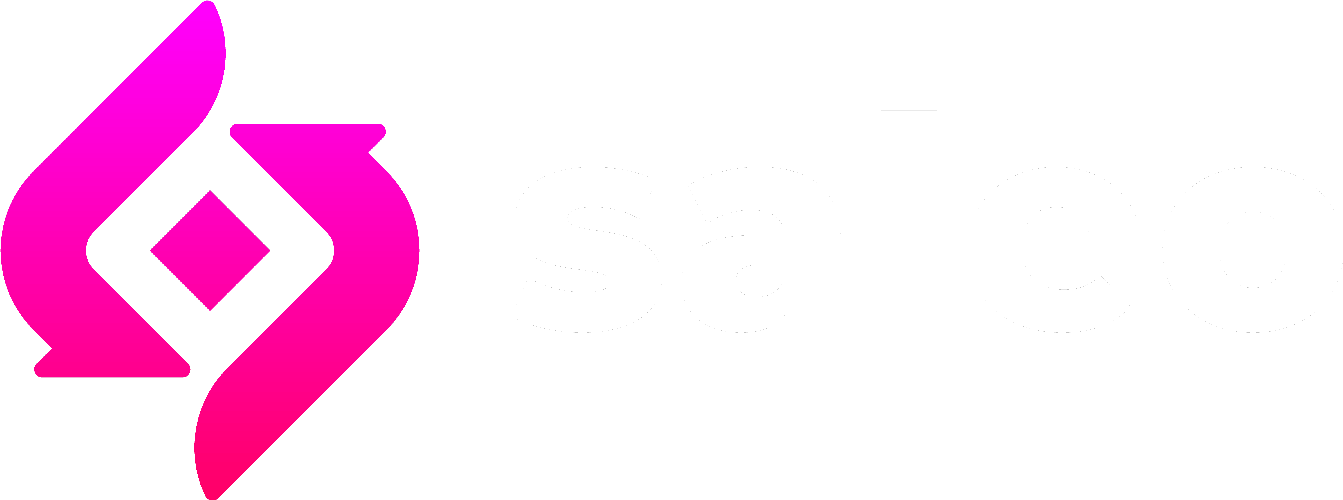Telling the perfect sales story starts with personalizing your sales demo environment. A great demo environment tells a story that the prospect can relate to. It brings them into your software product and helps to address the exact issues and areas of value that they’re interested in. Get this right and you will be able to close and win a lot more sales.
However, personalizing sales demo environments can be a daunting task. It involves deeply researching your leads and updating your demo presentations to match their scenario. This can take a lot of time and effort – things that busy sales teams are always short of.
Luckily, with the right tools and tactics, it’s possible to create a powerful, personalized sales demo with ease. We’ll explore some of the best practices for achieving this in our guide below.
The Benefits Of Personalizing Your Sales Demo Environment
Your sales demo environment plays a critical role in whether the sale is won or lost. One of the most effective ways to create a stronger sales demo environment is by personalizing the demo you give.
Instead of rehashing the same tables, graphs, and demonstrations for all leads, it’s incredibly important to demo your actual product with real, relevant data. Doing so provides a sales story that your prospects can connect with and gain real meaningful insights from. This is critical for driving their decision to close the sale.
Quite simply, your prospects want to attend a demo that is relevant to their business. They don’t want to listen to metrics that apply to anyone else but themselves. They also won’t want to access a non-functional “copy” of your product in the demo. Instead, prospects want to experience exactly what they can achieve by using your solution.
Personalizing the sales demo environment will help prospects see:
- How your product can solve their problems
- How they can use your product to gain an advantage over their competitors
- What specific use cases they can gain from your product
Get all of this right, and you will create a much more meaningful connection with each prospect on each sales demo. The results of this? Increasing sales demo engagement and closing more deals in your sales pipeline.
7 Best Practices For Personalizing Your Sales Demo Environment
There are various ways that you can personalize your sales demo environment. Let’s explore some of the most effective options.
Fully Capture The Solution
The trick to any good sales demo environment is to show the power of your software. To do this, you need to provide a complete overview of how your solution actually performs and what it can achieve. Make sure that you fit the solution into the company that you’re demoing to. This will build a stronger connection for the sale.
To do this, you’ll want to show examples of your software in use that speak to your prospect’s pain points and desires. This will help them develop trust in your products and understand how they can solve their problems – something that’s essential for boosting your demo close rate.
Prospects don’t want to hear a sales pitch or listen to you talk about your product. They want to see your software live and in action so that they can understand how it works and why they should use it. This has always been tricky, as it would require interactive product demo videos (which are very complex to create). However, with the right solution, you can still provide a personalized, realistic product experience using your actual product.
With Saleo, you can demo your actual product with custom data. Forget about screenshots and repeated videos of the same generic product in action. This lets your prospects explore your product more deeply, helps to properly answer questions, and lets your prospects leave feeling motivated by what your software can do.
So, don’t simply show the same product images, videos, and examples in your SaaS sales demo. Instead, use the tool, reveal how your solution actually works, and make sure to capture the entirety of the solution in your demo (and not just your product’s functionality).
Tell A Story (Using Real Data)
When a prospect hops onto a software sales demo, they want to figure out how your solution can actually help them. What value can it add to their business? What kind of return on investment will they be able to achieve? This is especially important when demoing to key decision makers in a B2B sales demo.
The best way to answer these questions is to use your demo to tell a story. Don’t simply show what your product is capable of – show how your product will help your prospects grow their business. This can be achieved through a kind of sales narrative, or storytelling, technique.
Guide your prospects through a step-by-step sales narrative that matches their industry and concerns. Provide context to your solutions, explain how they will use the software, and what kind of value it will deliver with each function.
A great way to do this is by adding use cases and success stories of your existing clients with real data. This will help inspire your prospects, develop trust, and motivate them about what they can achieve with your solution.
An essential part of telling a story in your product demo is understanding the characters of the story. Always do enough research before a demo to understand who your prospect is and what kind of solution they’re after. This will help you develop a narrative that brings them more value and is hyper-targeted toward their needs.
Try to gather this information before the demo. Collect information from your prospects, like what problem they’re trying to solve with your tool, what solutions their business is missing, or what their business goals are. This will let you personalize your demo environment to better match their business environment.
Talk To Your Customer’s Pain Points
A generic product demo environment won’t motivate your leads to complete a sale. Sure, your software might help businesses “save time”, but in what exact ways will it help your specific prospect save time?
A key part of personalizing your sales demo environment is to understand your client’s pain points and provide a solution to them.
Do some research into each lead and try to grasp what kind of struggles exist around their business and industry. Make sure to address these issues in your sales demo.
If you present solutions to problems your clients aren’t actually facing, then they won’t be interested in your product. If you dig into their pain points and provide a clear solution, they will want to sign up straight away.
You should also understand how to turn features into benefits. If you’re demoing a software solution, don’t just say “it can do this”, but rather say “it can do this which will save you 8 hours a week”.
Highlighting benefits instead of features addresses your client’s pain points, giving them more reason to purchase your solution. This could also help your prospects discover pain points and issues in their business workflow that they didn’t even know existed.
Personalize Images, Icons, And Logos In The Demo
This might seem like a small touch, but it makes an enormous difference to your sales demo environment. Personalizing your sales demo to include your prospect’s images, icons, and logos will help them get a better feel for how your product will actually work for them.
It may just be an aesthetic touch, but it helps to get your prospects into the mindset of using your solution. It also shows your prospects that you took the time to research their business and their branding, and produce a sales demo that is tailored toward them
Personalizing elements inside your product demo to better fit the company you are selling to helps to build a stronger connection with them. It makes your demo more relevant, more relatable, and more valuable. This brings you closer to winning the sale.
Tailor-made demos like this add more direct value to your prospects. It shows them how they can use your platform, what they can do with it, and what kind of use cases are relevant to them.
The more you customize elements of your demo presentation, even small elements, the bigger the impact will be on your prospects.
Avoid Generic Text And Titles
If you use the same sales demo presentation for every client, you won’t end up leaving a strong impression with any of them. Generic text and titles are a one-way ticket to an easily forgettable demo.
Before you present your sales demo, be sure to customize each text and title element to fit the company you’re presenting to. Understand what they would want from the software, and adjust your demo to match this.
In the most simple sense, this could be inserting their brand name or industry into the title. Better yet, try to add specific use cases, metrics, and scenarios that would only apply to their business. Add more personal contact around their business and try to match their tone of voice, instead of using a generic title.
Again, this develops more trust and helps to highlight the specific value that each prospect will get from your solution.
Use Customized Graphs And Metrics
Outdated demo environments, or demos that lack data, aren’t going to inspire your prospects. Instead, you want to present sales demos that directly resonate with your buyer. They want to gain actionable insights from your sales demo, and see how your product can actually help their business – not just help businesses in general.
To do this, you’ll need to generate new demo environments for each prospect you present to. The data you show a prospect needs to be specific to them, and it needs to speak to the problem they’re trying to solve.
Make sure that your sales demo environment is personalized to reflect customized graphs and metrics that match your leads. This could be by updating this data to reflect their industry, localization, business size, or types of operations.
Whatever the case, customized graphs and metrics will help potential clients see the value in what you offer. It will help them understand your product in relation to their business, which is essential for instilling confidence and closing a sale.
Monitor The Right Metrics In Your Demo
Your sales team should always be fine-tuning their demo environments. Even after making all of these changes to personalize their sales demos, there will still be elements of the demo that work and elements that need improvement.
In order to understand this, it’s important to monitor the right metrics and analytics that relate to your sales demo.
Sales demo solutions exist to help you understand things like:
- Demo completion rates
- What your most successful demos are
- What your least successful demos are
- Conversion rates
- What pages or features in your demo are most successful
Pinpointing these elements and comparing them to each other will help you improve future demos and close more deals.
Sales demo analytics tools let you use data to optimize your sales demos and find which areas need changes. This will help you steadily improve your sales demo personalization and performance.
Hyper-Personalize Your Sales Demo Environment With The Right Tool
In order to personalize your sales demo environment, you’ll need to have complete control over every element in your demo presentation. To easily customize and achieve this, use the right sales demo tool.
A solution like Saleo makes it easy to personalize every element of your demo – including elements like graphs, metrics, tables, text, images, icons, and more.
Saleo lets you demo your actual product while making it more complete with relevant, customizable data. This gives you greater control over your entire sales demo environment, ultimately helping you win more deals.
Final Thoughts
Personalized sales demo environments are essential for increasing your chances of closing more deals. The more you can show real value to your prospects, the easier it will be to close a sale with them.
These days, competition is tough in any industry. If you’re offering a software solution, chances are you have plenty of competitors to go up against – with each one offering a sales demo experience.
By personalizing your demos, you’ll be able to make a greater impact with every prospect. Ultimately, this means more closed deals in your sales pipeline. If you’re ready to make this happen, request a Saleo demo today!





